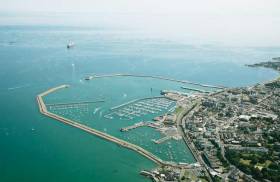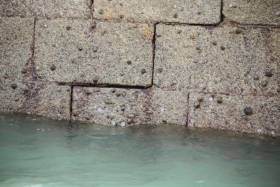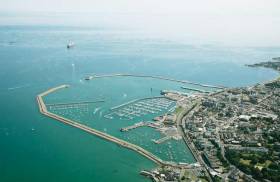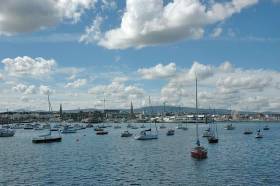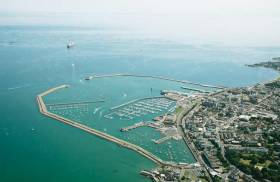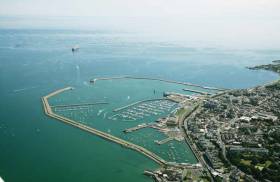Displaying items by tag: Dun Laoghaire Harbour Company
Dun Laoghaire Harbour’s former chief executive Gerry Dunne received a redundancy payment of €670,000 from the local authority that now owns the harbour, it’s been reported.
According to East Coast FM, Dun Laoghaire-Rathdown county councillors were told at a 2020 budget meeting on Wednesday 6 November that a single payment of €670,000 in redundancy was made in line with Department of Public Expenditure guidelines, with no sign-off required.
Dunne had been CEO of the Dun Laoghaire Harbour Company from 2009 until it was dissolved last year upon the harbour’s transfer to local authority hands.
Community Projects ‘In Jeopardy’ As Local Authority Takes On Dun Laoghaire Harbour Debts
#DLHarbour - Dun Laoghaire-Rathdown county councillors have suggested a potential increase in Local Property Tax to help offset Dun Laoghaire Harbour Company’s multi-million-euro liabilities, now that the harbour has been officially transferred to local authority control.
Cllr Barry Ward tweeted late last night (Wednesday 26 September) that Transport Minister Shane Ross had signed over responsibility for Dun Laoghaire Harbour “with no financial provision for the estimated €33.5 million debt now imposed on his own constituents, despite repeated calls for fairness from councillors.
“[Dun Laoghaire-Rathdown] cannot sustain this level of financial liability,” he added.
Minister @Shane_RossTD has tonight signed @DLHarbour over to @dlrcc with no financial provision for the estimated €33.5 million debt now imposed on his own constituents, despite repeated calls for fairness from councillors. DLR cannot sustain this level of financial liability. pic.twitter.com/DYENREpcv8
— Barry Ward (@barrymward) September 26, 2018
A slew of projects and developments in the Dun Laoghaire-Rathdown area — from Stillorgan Library to Glenalbyn Swimming Pool to the Marlay Park Masterplan — are now “all in jeopardy”, according to local councillor Barry Saul.
Glenalbyn Pool , Stillorgan Library , Marley running track , Fernhill Phase 2, Marley Park Masterplan all in jeopardy following Minister Ross decision to sign over DL Harbour and 33 million liabilities to Dun Laoghaire Rathdown Council pic.twitter.com/H1DDwI5J9E
— Barry Saul (@cllrbarrysaul) September 26, 2018
Cllr Lynsey McGovern added that “we can kiss goodbye to keeping commercial rates and property tax down now,” while Cllr Jim Gildea said even a 30% increase in LPT “would only give us €15m. I for one couldn’t vote to hoist that burden on our householders”.
Minister Ross confirmed back in April this year that “all assets and liabilities” of Dun Laoghaire Harbour Company would transfer to the local authority upon the former’s dissolution — and made clear that National Ports Policy does not provide for Exchequer funding “for any port company”.
The transfer of liabilities was branded as “unacceptable” at the time by local Green Party councillor Ossian Smyth.
Independent Senator Victor Boyhan was set to raise the issue of the harbour transfer and its financial implications for DLRCoCo in the Seanad this morning, as previously reported on Afloat.ie.
Update Friday 28 September: Cllr Barry Ward tweeted confirmation that Dun Laoghaire Harbour will come under control of Dun Laoghaire-Rathdown County Council next Wednesday 3 October.
Fine Gael councillors have called for a special meeting on the issue on the same day at 5pm. An invitation will be extended to Transport Minister Shane Ross.
The transfer order for @DLHarbour has been signed by Minister @Shane_RossTD. #DúnLaoghaire #Harbour will now come under the controll of @dlrcc on Wednesday next, 3 October. The Council was informed by letter yesterday. pic.twitter.com/SwGC9LLJ6c
— Barry Ward (@barrymward) September 28, 2018
#DLHarbour - Solicitors for Dun Laoghaire Harbour Company called for the retraction of “damaging and disparaging statements” made at a council meeting on the transfer of the port to local authority control, it has emerged.
According to today’s Sunday Times (6 May), the solicitors claimed that remarks by four Dun Laoghaire-Rathdown councillors at the meeting on 6 March “call into question the proper governance and management of the company.”
Mason Hayes & Currin repeated their demand on 16 March to DLRCoCo chair Tom Murphy, who replied that he was not responsible for statements made by other councillors in meetings, which are in general under qualified privilege.
Read more on this story from the The Sunday Times (behind the paywall).
Minister Says ‘No Immediate Health & Safety Issue’ In Dun Laoghaire Harbour Despite West Pier Damage
#DLHarbour - “There is no immediate health and safety issue with any pier in Dun Laoghaire.”
That was the message from Transport Minister Shane Ross in his reply to a Dáil question from local TD Richard Boyd Barrett earlier this week.
On the question of the risk assessment and due diligence reports conducted on Dun Laoghaire Harbour Company, Minister Ross said the process “is a matter for” the chief executive of Dun Laoghaire-Rathdown County Council, who concluded last month “that the most appropriate model for the [harbour] company is the transfer and dissolution model.”
The minister confirmed earlier this month that “all assets and liability” of Dun Laoghaire Harbour Company would transfer to the local authority.
“I understand that the main issue now outstanding relates to remedial works in the harbour and how those works will be funded,” said Minister Ross in his response to Deputy Barrett, reiterating that National Ports Policy “clearly states that there is no Exchequer funding for any port company.
“My Department has been informed that there is no immediate health and safety issue with any pier in Dun Laoghaire,” he continued.
The statement comes after recent concerns over damage to the West Pier after Storm Emma, as previously reported on Afloat.ie.
Minister Confirms ‘All Assets & Liabilities’ Of Dun Laoghaire Harbour Company Will Transfer To Local Authority
#DLHarbour - “All assets and liabilities” of Dun Laoghaire Harbour Company will transfer to the local authority upon its pending dissolution — with no additional State funding available, the Minister for Transport has confirmed.
Shane Ross was responding in writing to a parliamentary question from local independent county councillor Michael Merrigan, which asked the minister to specify if any funding would be provided “to create a reserve to assist Dun Laoghaire-Rathdown County Council in outstanding liabilities as part of a final agreement of transfer”.
“National Ports Policy recognised that the future of Dun Laoghaire port lies in marine leisure, marine tourism, cultural amenity and urban redevelopment,” Minister Ross wrote. “In addition, it clearly states that there is no Exchequer finding for any port company.”
Dún Laoghaire Hbr. transfer to @dlrcc - reply to PQ on approx. €33.5 million burden on residents & businesses in county. @Shane_RossTD - Minister for Transport (AND Closed Garda Stations, Demolished Swimming Pools & Judicial Appointments) needs to clarify funding! pic.twitter.com/fqVGCA1B5H
— Michael Merrigan (@VoteMerrigan) April 18, 2018
Confirming that the existing port company’s assets and liabilities would transfer to DLRCoCo, the minister added that “the port will continue to generate income from marine-related and other activities such as rents, leases and car parks”, and that any remedial and engineering works “are normally prioritised” and funded via planned allocations.
Cllr Merrigan’s question raised concerns that Dun Laoghaire Harbour company’s financial liabilities “are greater than its liquid assets” and that the transfer comes with “risks and potential exposure” to the local authority.
The minister “needs to clarify funding” on the foot of a “€33.5 million burden on residents and businesses” in the county, the councillor added.
Last week, local Green Party councillor Ossian Smyth said the transfer of liabilities to the local authority is “not acceptable”.
#DLHarbour - The proposal by Transport Minister Shane Ross to transfer Dun Laoghaire Harbour’s liabilities to the local authority along with its assets is “not acceptable”, according to a local councillor.
Last Monday 9 April, Green Party Cllr Ossian Smyth shared the news that the minister had decided the “responsibility for the future of the port” lies with Dun Laoghaire-Rathdown County Council, in line with National Ports Policy.
Local campaigners broadly welcomed the news after a long period of uncertainly over the port’s future, with People Before Profit TD Richard Boyd Barrett hailing the decision as a victory for “people power”.
But now concerns have been raised with the particulars of Minister Ross’ letter to DLRCoCo chief executive Philomena Poole, in which he states that his “preferred model of transfer is that of dissolution of [Dun Laoghaire Harbour Company] and the transfer of all assets, liabilities and employees to the County Council.”
Cllr Smyth told Afloat.ie: “Dun Laoghaire’s taxpayers should not be left on the hook for debts accumulated by the harbour company while pursuing far-fetched projects like the super cruise ship berth, the floating hotel and floating homes, a hotel on the Carlisle Pier and so on.”
Govt Urged To Avoid Delay In Dun Laoghaire Harbour Transfer
#DLHarbour - Transport Minister Shane Ross must ensure there is “no delay” in the transfer of Dun Laoghaire Harbour to the local authority, as Dublin Live reports.
Earlier this week it emerged that Minister Ross had made his determination that the “responsibility for the future of the port lies with DLR County Council”.
The move is being hailed as a victory for “people power” by People Before Profit TD Richard Boyd Barrett, a long-time local campaigner for bringing the harbour under public control.
Minister Ross is set to meet with the chief executive of Dun Laoghaire-Rathdown County Council to discuss the dissolution of Dun Laoghaire Harbour Company and the transfer of its assets to the local authority.
“[Successive Transport Ministers’] failure to act has meant that significant liabilities have built up and a lot of public money has been wasted,” said Deputy Boyd Barrett.
“The Government needs to now stump up the money needed to cover these liabilities, while ensuring no delay in the transfer of the harbour into full public control.”
Meanwhile, DLRCoCo has signed a €9 million contract for the long-awaited redevelopment of the Dun Laoghaire Baths adjacent to the harbour, as previously reported on Afloat.ie.
Is Dun Laoghaire Harbour Finally In County Council Hands?
#DLHarbour - Has Dun Laoghaire Harbour finally been transferred to the local county council?
That appears to be the case, according to a tweet yesterday evening (Monday 9 April) from Green Party Councillor Ossian Smyth.
The tweet quotes Transport Minister Shane Ross, who has sole discretion on the matter, as determining that “responsibility for the future of the port lies with DLR County Council”.
Shane Ross (as Transport Minister) has agreed to dissolve Dún Laoghaire Harbour Company on foot of a request from the council. The council will take over the running of the Harbour. pic.twitter.com/4SITCaZyDd
— Cllr Ossian Smyth (@smytho) April 9, 2018
Dun Laoghaire-Rathdown County Council was understood to be meeting yesterday following its earlier vote to recommend the dissolution of Dun Laoghaire Harbour Company and transfer its assets to the local authority.
Afloat.ie will have more on this story as it develops.
See also: Could Council Vote Signal a New Master Plan for Dun Laoghaire Harbour?
The recent vote by Dun Laoghaire Rathdown County Council (DLR) effectively recommends that the Minister for Transport, Tourism and Sport dissolve the Harbour Company and transfer its assets to the County Council. The right to do this is given to the Minister under Article 28 of the Harbours Act 2015, and, importantly, this action is strongly supported by the Nationals Ports Policy.
The debate in the Council Chambers showed that there is an appetite to bring the harbour under the auspices of the County Council, not only amongst the Councillors but also at senior management level. In recommending this course of action, Philomena Poole, DLR’s CEO, addressing the council, stated that this was an “opportunity to use government policy for the betterment of the county and to ensure the integration at a policy and development level of the harbour”.
However, there is the small question of who pays for the works that would put the harbour into a “taking in charge” condition, essentially that state where no capital works are required to prevent further deterioration of the infrastructure. Consultants employed by the County Council estimate this to be €33m, of which approximately €7m covers the outer piers and €8m is for repairing berth no 1 on the East Pier. Councillors were unanimous that the €33m was not something that the county council could or should underwrite and this hot potato was very firmly hurled towards national government. Ironically, recent damage to East Pier during Storm Emma highlighted how DLHC is unsustainable an entity.
There were strong opinions expressed during the debate about the role of the Harbour Company, none of them positive, not only concerning the Harbour Company’s recent progress or lack of it, but also about the non–cooperation with the consultants as they endeavoured to calculate the liabilities. Several referred to the “dysfunctionality” of the Harbour Company while Councillor John Bailey was particularly scathing of the Harbour’s approach noting that the Harbour Company “is dead, not even on life support.” He was to the forefront amongst Councillors concerned that the ‘snapshot’ provided by the consultants through the risk report fell short of the information that would be available in a due diligence report.
A number of motions were withdrawn before the final vote in the interest of getting the principal motion passed. One of these suggested that the Minister effectively impose a “cease and desist” order on the Harbour Company to restrict, inter alia, any transfer of assets and new leases or rental agreements. At present the Harbour Company are actively seeking expressions of interest in the Carlisle Pier regeneration, conducting a “market consultation” on the provision of a national watersport centre and entering a procurement process for the provision of floating homes in the Coal Harbour.
Another motion that was withdrawn was a proposal to create a Harbour Stakeholder’s Committee.
The activity in the Council Chamber begs the question where next? Those who were seeking to engage with the Harbour Company on current projects must be concerned about the longer term viability. With the future governance of the harbour in doubt, where do the current planning applications for developments on harbour lands fit in?
While the County Council vote is indicative of the intent of Dun Laoghaire Rathdown, it is perhaps only the beginning of the end and maybe even back to the drawing board for a new master plan for the harbour.
The council meeting heard that the decision to transfer is wholly reserved to the Minister for Transport.
Is it a bright new future or same old same old for the 200–year–old harbour?
Clearly the ball is now firmly in the Minister’s court.
Read also: Without a Harbour Czar, Dun Laoghaire’s All at Sea
Dun Laoghaire Harbour’s ‘Floating Homes’ Tender Goes Live
#Property - Dun Laoghaire Harbour Company has now launched the procurement process for its plans to develop ‘floating homes’ on the waterfront, as promised in January.
The tender published to the State’s eTenders website is “seeking proposals for the development and operation of affordable floating homes within the harbour” by Thursday 12 April.
The concession notice for the estimated €15 million development stipulates that some 60% of the Coal Harbour area has been earmarked for the plan, which is expected to comprise around “50 single-storey affordable floating homes for rental by the candidate.”
The harbour company adds: “It is important that any development is high quality and sensitive to the site’s high profile waterside location.”



























